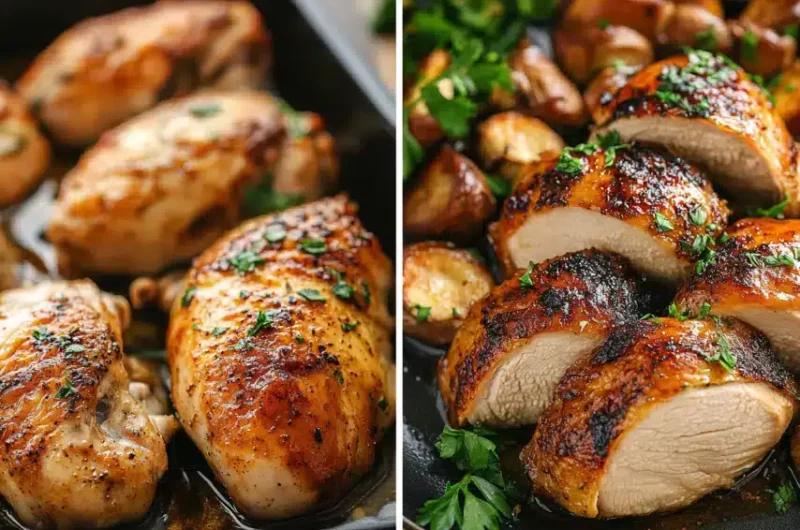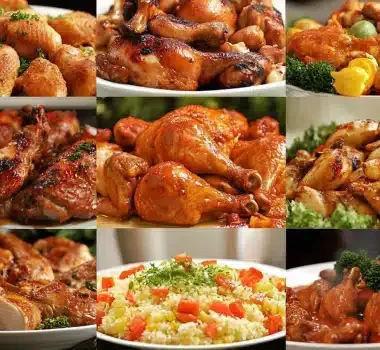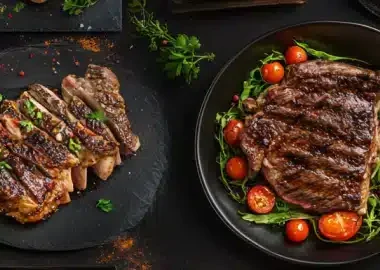The quest for the perfectly cooked chicken often leads to one central question: what is the secret to moist chicken? Dry, lackluster chicken is a common kitchen woe, but fear not! Achieving juicy, tender chicken is not a matter of luck, but rather a combination of knowledge, technique, and a few key strategies. This article will delve deep into the various methods and tips to help you consistently produce chicken that is flavorful and moist, addressing all the most common mistakes that can lead to dry chicken. So, let’s begin the exploration and discover how to make every chicken meal a success.
The Power of Brining for Moist Chicken
What is Brining and How Does it Work?
Brining is a technique that involves submerging your chicken in a saltwater solution, which will allow the chicken to absorb extra moisture, leading to a much juicier result. Brining works through osmosis, as salt molecules draw the liquid into the chicken, and this increased moisture level means the chicken will stay more succulent during the cooking process. By adding herbs and aromatics to the brining liquid you can add extra flavor to your chicken, as well. This simple technique can make a huge difference in the final result.
Different Types of Brines: Wet vs Dry
There are different ways to brine, with the two main methods being wet and dry brining. Wet brining is when you submerge the chicken in a saltwater solution. Dry brining, on the other hand, is when you coat the chicken with salt and let it rest. Both of these methods help the chicken retain moisture. The best one depends on your preferences, with wet brining adding more moisture and dry brining being less messy and quicker. The Science of Brining can be further explored at The Science of Brining.
Marinating for Flavor and Moisture
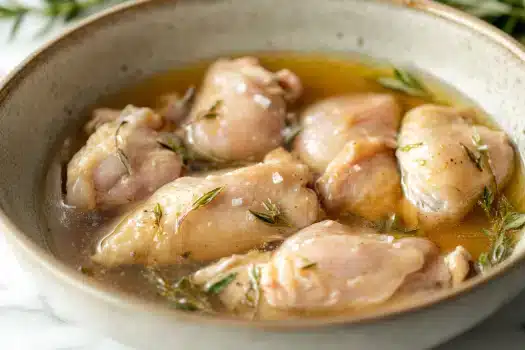
How Marinades Work to Keep Chicken Juicy
Marinades are great for both adding flavor and keeping chicken juicy. They work by using an acidic liquid (like lemon juice or vinegar), which helps break down the proteins in the chicken, therefore allowing it to better absorb moisture, and flavour. Adding oils to your marinade will also help to keep your chicken moist during cooking. Marinating is a great way to make flavorful, juicy chicken every single time.
Choosing the Right Marinade for Different Chicken Cuts
When selecting a marinade, consider the type of chicken you will use. For leaner cuts like chicken breasts, a marinade with a good amount of oil will help keep it moist during cooking. If you’re using fattier cuts, like chicken thighs, you can opt for a lighter marinade. Experiment with different marinade combinations to discover your favorite flavors. Effective marinating is a step towards a juicy result every single time.
The Importance of Cooking Temperature Control
Understanding Internal Temperatures for Chicken
Knowing the safe internal temperature of chicken is a crucial point for ensuring both safety and moisture. Undercooked chicken is unsafe to eat, while overcooked chicken becomes dry. The target temperature for chicken is 165°F (74°C), which is the temperature at which any harmful bacteria will be killed. This step is critical for achieving both a safe and juicy meal. Keep an eye on the temperature to maintain the perfect moisture in your meal.
Using a Meat Thermometer for Precision
Using a meat thermometer is essential for ensuring your chicken is perfectly cooked, as it takes away the guesswork of when the chicken is done, therefore ensuring the proper cooking temperature. Insert the thermometer into the thickest part of the chicken to get an accurate reading. The use of a meat thermometer is the key to avoiding overcooking, as this helps to keep the chicken juicy and tender.
Choosing the Right Cooking Method for Moist Results
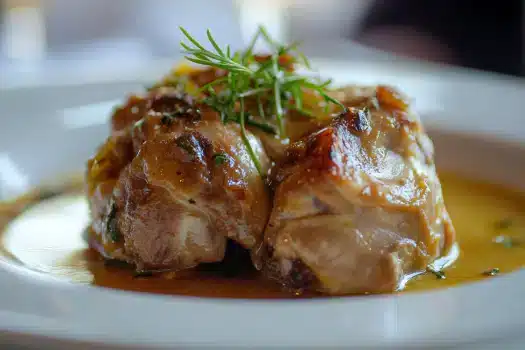
Slow Cooking: The Key to Tenderness and Moisture
Slow cooking is a fantastic way to achieve exceptionally tender and moist chicken, as the gentle heat cooks the chicken evenly and prevents it from drying out. This method allows the chicken to cook low and slow, which will retain the moisture, giving it time to become more tender. Whether you use a slow cooker or braise the chicken in the oven, slow cooking will consistently create juicy results every single time. This method is known to create very satisfying results.
Steaming and Poaching: Gentle Cooking Methods
Steaming and poaching are very gentle cooking methods that excel at moisture retention, they allow the chicken to cook without losing its natural juices, resulting in very moist and tender chicken. Steaming is a great way to cook chicken, especially when you’re trying to avoid added fats. Poaching is when you gently simmer the chicken in a flavorful liquid. Both of these methods will guarantee a succulent result.
The Art of Basting for Extra Moisture
Basting Techniques: Keeping Chicken from Drying Out
Basting involves spooning the cooking juices or other liquids over the chicken during cooking, which will greatly help to keep the chicken from drying out. The liquid will help to keep the chicken moist during cooking, therefore adding extra flavor. The basting method is very effective, and a key to getting delicious juicy chicken. You should aim for basting every 15-20 minutes.
When to Baste: Timing for Best Results
Basting your chicken at certain times during the cooking process is very important for the best result. Basting too early might interfere with the crisping of the skin, while doing it too late may not be as effective. Basting during intervals ensures that your chicken stays moist without losing its skin texture.
The Role of Fat in Moist Chicken
Understanding Fat Content in Chicken
Understanding the fat content in chicken is key to understanding how to make it moist. Dark meat, like thighs and drumsticks, has more fat than white meat, like chicken breasts. The fat is what helps keep chicken moist and gives it more flavour. Chicken thighs are known to be more juicy and tender, compared to chicken breasts. Knowing the difference between these cuts helps you chose the correct cut for your cooking goals.
Using Fat to Your Advantage: Cooking Techniques
You can use chicken fat to your advantage during the cooking process to retain moisture and enhance flavor, therefore adding to a more satisfying meal. For example, when roasting, leave some of the skin on and baste the chicken with the rendered fat, which will create a self-basting effect. These techniques will help keep your chicken moist and flavorful, making your chicken dish all the more amazing.
Resting Time: An Essential Step
Why Resting Chicken is Important
Allowing your chicken to rest after cooking is essential for achieving maximum juiciness and tenderness, as it allows the juices to redistribute throughout the meat, therefore preventing them from running out when you cut into it. This step is very important, and not to be skipped, if you want perfectly juicy chicken. The waiting period makes a huge difference in the final results. This step will lead to moist and tender chicken.
How Long to Rest Chicken for Best Results
Resting chicken for at least 5-10 minutes is best for smaller pieces, and for 10-20 minutes for larger portions or whole chickens. The amount of time depends on the size of your chicken. Allowing the chicken to rest for the proper time will allow the juices to redistribute, resulting in very juicy chicken. You should rest your chicken before cutting into it for the best results.
Common Mistakes that Lead to Dry Chicken
Overcooking Chicken: A Major Culprit
Overcooking chicken is one of the main reasons why chicken becomes dry and less appealing, so try to avoid this common mistake. When chicken is overcooked, the proteins break down and lose the moisture, leading to a dry and tough result. Overcooking chicken is a very common mistake that can ruin your meal, so keep a close watch while cooking. It’s always better to undercook your chicken a little and cook it more if needed.
Not Using a Meat Thermometer: A Common Error
Failing to use a meat thermometer is one of the most common errors, as this means you’re relying on guesswork, and risking overcooking or undercooking your chicken. Without a meat thermometer, you’re essentially going in blind, therefore leading to dryness. Investing in a good meat thermometer is a game changer, and one of the first steps to avoid dry chicken.
Special Techniques for Extra Moist Chicken
Spatchcocking: For Even Cooking and Moisture
Spatchcocking is a technique that involves removing the backbone of a chicken, which allows the chicken to lay flat, leading to more even cooking and crispier skin, as well as quicker cooking time, as well as it can help in creating a juicy result. This technique reduces cooking time and provides more even cooking overall. The spatchcocking technique is an excellent way to make sure your chicken will have the best moisture level, with crispy skin.
Using a Dutch Oven: Creating a Moist Environment
Cooking chicken in a Dutch oven is an excellent way to create a moist cooking environment, as it helps to trap steam and moisture, which results in tender, juicy chicken. Because the heat is evenly distributed through the Dutch oven, this helps the chicken to cook without drying out. Using a Dutch oven is a great way to create incredibly juicy chicken every time.
Conclusion: Mastering the Art of Moist Chicken
Achieving perfectly moist chicken requires a combination of the correct techniques, timing, and a bit of practice. Using the tips discussed, like brining, marinating, controlling cooking temperatures, and allowing for adequate resting time, you can transform your chicken dishes. So, the quest of what is the secret to moist chicken? is achievable by using the techniques described in this article.
FAQs
- Why is my chicken always dry?
Dry chicken often results from overcooking, not brining, or not using proper techniques that retain moisture, such as marinating. These common mistakes will dry out your chicken. - Does brining really make a difference?
Yes, brining makes a significant difference by helping the chicken retain moisture, resulting in a juicier final result. The brining process helps to create succulent meat. - How long should I brine chicken for?
The brining time for chicken depends on the cut. Chicken breasts should brine for 30 minutes to 2 hours, whereas whole chickens benefit from 8 to 12 hours. - Is it better to bake or fry chicken to keep it moist?
Baking can keep chicken moist by cooking it at a low temperature with added moisture, whereas frying is better suited for achieving crispy skin, and may lead to dryness if not done correctly. - Can I make moist chicken without using fat?
Yes, you can make moist chicken without fat by using techniques such as brining, steaming, and poaching, as these don’t require added fats. These methods help in preserving the natural juices.

